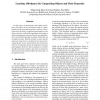Free Online Productivity Tools
i2Speak
i2Symbol
i2OCR
iTex2Img
iWeb2Print
iWeb2Shot
i2Type
iPdf2Split
iPdf2Merge
i2Bopomofo
i2Arabic
i2Style
i2Image
i2PDF
iLatex2Rtf
Sci2ools
ICPR
2010
IEEE
2010
IEEE
Learning Affordances for Categorizing Objects and Their Properties
In this paper, we demonstrate that simple interactions with objects in the environment leads to a manifestation of the perceptual properties of objects. This is achieved by deriving a condensed representation of the effects of actions (called effect prototypes in the paper), and investigating the relevance between perceptual features extracted from the objects and the actions that can be applied to them. With this at hand, we show that the agent can categorize (i.e., partition) its raw sensory perceptual feature vector, extracted from the environment, which is an important step for development of concepts and language. Moreover, after learning how to predict the effect prototypes of objects, the agent can categorize objects based on the predicted effects of actions that can be applied on them.
| Added | 02 Aug 2010 |
| Updated | 02 Aug 2010 |
| Type | Conference |
| Year | 2010 |
| Where | ICPR |
| Authors | Nilgun Dag, Ilkay Atil, Sinan Kalkan, Erol Sahin |
Comments (0)

